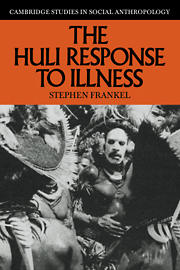Book contents
- Frontmatter
- Contents
- List of figures
- List of tables
- Glossary and note on orthography
- Preface
- 1 Introduction
- 2 Historical perspectives
- 3 Huli society
- 4 Ideas of health and illness
- 5 Morbidity, explanations and actions: quantitative perspectives
- 6 Illness attributed to proximate causes
- 7 Explanations relating to sexuality and growth
- 8 Illness grounded in social relations
- 9 Spirits and God
- 10 Patterns of response
- References
- Index
- Cambridge Studies in Social Anthropology
5 - Morbidity, explanations and actions: quantitative perspectives
Published online by Cambridge University Press: 14 September 2009
- Frontmatter
- Contents
- List of figures
- List of tables
- Glossary and note on orthography
- Preface
- 1 Introduction
- 2 Historical perspectives
- 3 Huli society
- 4 Ideas of health and illness
- 5 Morbidity, explanations and actions: quantitative perspectives
- 6 Illness attributed to proximate causes
- 7 Explanations relating to sexuality and growth
- 8 Illness grounded in social relations
- 9 Spirits and God
- 10 Patterns of response
- References
- Index
- Cambridge Studies in Social Anthropology
Summary
The nature and severity of the illnesses to which people are exposed may influence their view of illness and guide their responses to it. For example, where infant mortality rates are very high, illnesses in young children may lead to less complex responses than illnesses of similar gravity in adults. Conversely, the burden of illness is likely to differ according to age, sex, division of labour and, in highly differentiated societies, class and status. These differences may reflect societal influences upon illness. A simple example from the Huli is the difference between the skin lesions of men and of women that follow from the sorts of tasks that they perform. As a background to these and other discussions I will therefore present an analysis of the burden of illness to which Huli are exposed.
Hulis pay more attention to some complaints than others. The anthropologist is also likely to approach the array of illnesses selectively according to the focus of his or her study. To place both these aspects of selective attention in perspective, I will also present a breakdown of types of explanations of illness in all episodes of illness occurring in a sample population.
The Huli have available to them a wide range of alternative treatment strategies. These include simple home remedies, more intricate traditional cures, recourse to the facilities of the Department of Public Health, various forms of Christian faith-healing and inaction.
- Type
- Chapter
- Information
- The Huli Response to Illness , pp. 60 - 80Publisher: Cambridge University PressPrint publication year: 1986



